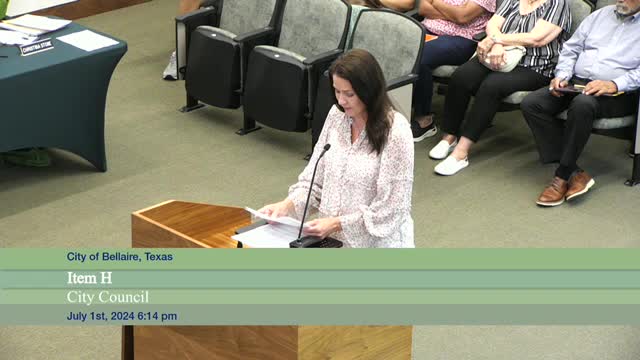Residents Rally Against High Density Development in Bel Air
July 01, 2024 | Bellaire, Harris County, Texas

This article was created by AI summarizing key points discussed. AI makes mistakes, so for full details and context, please refer to the video of the full meeting. Please report any errors so we can fix them. Report an error »

Residents of Bel Air voiced strong opposition to proposed changes in zoning regulations during a recent city council meeting, particularly concerning the multifamily development at Pont Alba. The meeting highlighted a deep concern among community members about maintaining the character of their neighborhoods, which they believe is threatened by increased density and the potential for crime associated with larger apartment complexes.
Several speakers emphasized their desire to preserve Bel Air as a \"city of homes,\" arguing that the introduction of multifamily dwellings would disrupt the small-town charm that attracted many to the area. Concerns were raised about the loss of privacy, increased noise, and traffic congestion that could result from higher-density developments. Residents expressed fears that the proposed changes could lead to a decline in property values and a deterioration of community safety.
Danielle, a resident, articulated the collective sentiment by stating that many neighbors do not wish to see multifamily dwellings in their community. She urged the council to consider reducing the number of residences per acre for any future developments. Other residents echoed her sentiments, citing personal experiences with noise disturbances and parking issues linked to existing multifamily units.
Kenneth Lewis, another speaker, highlighted the importance of balancing property rights with community interests, suggesting that the council should work collaboratively with developers to ensure that any new projects align with the desires of current residents. He cautioned against making hasty decisions that could lead to litigation, emphasizing the need for a thoughtful approach to zoning changes.
The developer of Pont Alba, Mark Musumeci, defended the proposed density changes, arguing that the current zoning does not reflect the urban context of the property. He claimed that the proposed adjustments would allow for a more economically viable project that could enhance the community. However, many residents remained skeptical, fearing that such developments would not align with their vision for Bel Air.
As the meeting concluded, the council was left to weigh the passionate arguments from residents against the potential benefits of increased development. The outcome of this discussion could significantly shape the future of Bel Air, as community members continue to advocate for their vision of a safe, family-oriented neighborhood.
Several speakers emphasized their desire to preserve Bel Air as a \"city of homes,\" arguing that the introduction of multifamily dwellings would disrupt the small-town charm that attracted many to the area. Concerns were raised about the loss of privacy, increased noise, and traffic congestion that could result from higher-density developments. Residents expressed fears that the proposed changes could lead to a decline in property values and a deterioration of community safety.
Danielle, a resident, articulated the collective sentiment by stating that many neighbors do not wish to see multifamily dwellings in their community. She urged the council to consider reducing the number of residences per acre for any future developments. Other residents echoed her sentiments, citing personal experiences with noise disturbances and parking issues linked to existing multifamily units.
Kenneth Lewis, another speaker, highlighted the importance of balancing property rights with community interests, suggesting that the council should work collaboratively with developers to ensure that any new projects align with the desires of current residents. He cautioned against making hasty decisions that could lead to litigation, emphasizing the need for a thoughtful approach to zoning changes.
The developer of Pont Alba, Mark Musumeci, defended the proposed density changes, arguing that the current zoning does not reflect the urban context of the property. He claimed that the proposed adjustments would allow for a more economically viable project that could enhance the community. However, many residents remained skeptical, fearing that such developments would not align with their vision for Bel Air.
As the meeting concluded, the council was left to weigh the passionate arguments from residents against the potential benefits of increased development. The outcome of this discussion could significantly shape the future of Bel Air, as community members continue to advocate for their vision of a safe, family-oriented neighborhood.
View full meeting
This article is based on a recent meeting—watch the full video and explore the complete transcript for deeper insights into the discussion.
View full meeting
